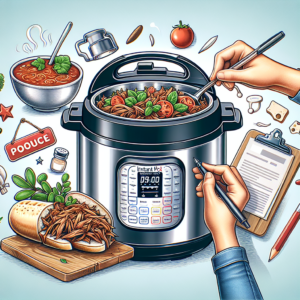Instant Pot What Is This Plastic Cup In The Back Of Some Models
Introduction to the Instant Pot’s Condensation Collector
“Instant Pot What Is This Plastic Cup In The Back Of Some Models” is a question that intrigues many users of this versatile kitchen appliance. The Instant Pot has become a household name, known for its efficiency and convenience in cooking. However, it’s the small and often unnoticed features, like the plastic cup – officially known as the condensation collector – that pique curiosity. This article aims to explore this component in detail, discussing its purpose, history, significance, and maintenance.
Understanding the Condensation Collector
The Purpose of the Plastic Cup
The plastic cup attached to some Instant Pot models serves a crucial function. Officially known as the condensation collector, it is designed to catch excess steam and moisture that condenses during the cooking process. This feature is particularly important in high-pressure cooking where steam is a byproduct.
How It Works in Cooking
During cooking, especially under pressure, steam condenses into water. Without a proper outlet, this condensation can create a mess. The condensation collector efficiently captures this moisture, keeping kitchen surfaces dry and clean.
Pressure Cooking: The Early Days
Origins of Pressure Cooking
The concept of pressure cooking dates back to the 17th century, with the first known pressure cooker invented by French physicist Denis Papin in 1679. Papin’s innovation, dubbed the “Steam Digester,” was designed to reduce cooking time and enhance the efficiency of food preparation. The basic principle was to use high pressure to increase the boiling point of water, thus cooking food faster.
Early Designs and Challenges
The early pressure cookers were rudimentary and faced numerous challenges. They were primarily made from heavy cast iron and lacked effective safety measures, making them dangerous. These early models were prone to explosions due to the high pressure, as they lacked the safety valves and regulated pressure release systems found in modern pressure cookers. The use of these early pressure cookers was limited and often feared because of these safety concerns.
Evolution and Safety Improvements
Throughout the 18th and 19th centuries, pressure cooking technology slowly evolved. The 20th century saw significant improvements, particularly in safety features. The invention of the pressure regulator valve in the early 1900s was a major advancement, allowing excess steam to be released and preventing the likelihood of explosion. These enhancements paved the way for pressure cookers to become a more common and trusted tool in household kitchens.

Pressure Cooking Across Cultures
Global Popularity and Adaptation
- The adoption of pressure cooking across various cultures demonstrates its versatility and efficiency. Each region has molded pressure cooking to fit its unique culinary traditions and ingredients, leading to a rich diversity in its usage worldwide.
Asian Cuisine
Quick Cooking of Staples
In Asian kitchens, pressure cookers are essential for swiftly preparing staple foods like rice and lentils. The high-pressure environment significantly reduces cooking times, which is particularly useful for dishes that would traditionally take hours to prepare.
Flavorful Dishes
Pressure cookers are also employed for intricate dishes like biryani and various curries. The intense pressure helps in deeply infusing spices into the food, enhancing the flavors and reducing cooking time without sacrificing the dish’s integrity.
Mediterranean and European Cuisine
Hearty Stews and Soups
Countries around the Mediterranean utilize pressure cookers for making stews and soups. These dishes, known for their long simmering times, benefit greatly from pressure cooking, which tenderizes meats and melds flavors more quickly.
Italian Risotto
In Italian cuisine, pressure cookers have revolutionized the preparation of risotto. This dish, which requires constant attention and stirring, can be made more efficiently in a pressure cooker, achieving the desired creamy texture with less labor.
Latin American Cuisine
Preparation of Beans
Beans, a cornerstone in Latin American cooking, are often prepared in pressure cookers. This method drastically cuts down the cooking time for beans, which otherwise require extensive soaking and simmering.
Tenderizing Meats
Tough cuts of meat, common in various Latin American dishes, are made tender and flavorful through pressure cooking. This method breaks down tough fibers in the meat, making it succulent and rich in taste.
Indian Cuisine
Dals and Legumes
In India, pressure cookers are indispensable for cooking dals (lentils) and legumes. These ingredients form the base of many Indian dishes and benefit from the quick cooking and flavor infusion that pressure cooking provides.
Sweets and Desserts
Pressure cookers are also used for traditional Indian sweets and desserts like kheer (rice pudding) and chenna poda (cheese dessert), where the consistent heat aids in achieving the perfect texture.

-
African Cuisine
Stews and Tagines
In African cooking, particularly in North African countries, pressure cookers are used for preparing stews and tagines. These dishes, often containing a mix of meat, vegetables, and spices, are cooked to perfection in a fraction of the traditional cooking time.
Grains and Cereals
Pressure cookers also aid in the quick preparation of various grains and cereals, which are staples in many African diets. This method retains the nutritional value while reducing the cooking time.
Southeast Asian Cuisine
Broths and Noodle Dishes
In Southeast Asian countries, pressure cookers are often used for making broths and noodle dishes. The rapid cooking method helps in extracting flavors from ingredients like bones and spices, essential for a rich broth base.
Meat Dishes
Pressure cooking is also popular for preparing meat dishes, where the method tenderizes meat efficiently, making it ideal for local recipes that often use tougher cuts of meat.
The global adoption of pressure cooking illustrates its significance in various culinary traditions. From quick-cooking staples in Asia to tenderizing meats in Latin America, and preparing hearty stews in Mediterranean countries, the pressure cooker has become an invaluable tool in kitchens around the world. This adaptation across cultures not only shows the versatility of pressure cooking but also its ability to enhance traditional cooking methods, making it a beloved practice in diverse culinary landscapes.
Influence on Traditional Cooking Methods
The adoption of pressure cooking has transformed traditional cooking methods in many cultures. Dishes that once took hours to cook can now be prepared in a fraction of the time, without compromising flavor. This has led to a shift in cooking practices, making pressure cooking a favored method for busy households and professional kitchens alike.
The early days of pressure cooking were marked by innovation but also by challenges and dangers. Over time, advancements in design and safety have transformed pressure cookers into a staple kitchen appliance. The adaptation of pressure cooking across different cultures highlights its versatility and the way it has revolutionized traditional cooking methods worldwide. This historical context sets the stage for understanding the modern iterations of pressure cooking appliances, such as the Instant Pot, and their place in contemporary cuisine.

Historical Context of the Condensation Collector
Origins of Pressure Cooking
The concept of pressure cooking dates back to the 17th century, but it was not until the 20th century that pressure cookers became common in household kitchens. These early models lacked many of the safety features we see today.
Development of the Instant Pot
The Instant Pot, emerging in the 21st century, revolutionized pressure cooking by integrating modern technology. This included electronic controls and safety features, one of which is the condensation collector. Its inclusion reflects a deep understanding of the pressure cooking process and its impact in a domestic setting.
Design and Material of the Condensation Collector
Choosing Plastic for Durability and Safety
The decision to use plastic for the condensation collector is based on several factors. Plastic is not only lightweight and durable but also heat-resistant, making it ideal for handling high temperatures during cooking. Additionally, plastic is non-reactive, ensuring no alteration in the flavor or safety of the food.
Ergonomic and Practical Design
The design of the condensation collector prioritizes practicality and user convenience. It is shaped and sized to efficiently collect moisture while being unobtrusive. Its easy-to-remove feature allows for hassle-free maintenance.
Maintenance and Care of the Condensation Collector
Cleaning for Hygiene and Performance
Regular cleaning of the condensation collector is essential. After each use, it should be detached, cleaned with soapy water, rinsed, and dried thoroughly. This prevents mold and odor and maintains the appliance’s optimal performance.
Regular Inspection and Replacement
Inspecting the condensation collector for wear and tear is crucial. Over time, the plastic may show signs of aging, such as cracks or warping. Replacing the collector when needed is important for maintaining the Instant Pot’s efficiency and safety.
Importance in Instant Pot Cooking
Ensuring a Clean Cooking Environment
By collecting excess moisture, the condensation collector helps maintain a clean and safe cooking environment. It prevents spillage and water damage to countertops, enhancing the overall cooking experience.
Supporting the Instant Pot’s Functionality
The condensation collector plays a subtle yet vital role in the functionality of the Instant Pot. It ensures that moisture is managed effectively, which is essential for the proper operation of steam release mechanisms and other components.
Future Directions and Innovations
Potential for Material and Design Enhancements
As technology evolves, we may see advancements in the materials and design of the condensation collector. Innovations could include more durable materials or designs that accommodate larger volumes of condensation, catering to the evolving needs of modern kitchens.
Integration of Smart Features
Future versions of the Instant Pot might incorporate smart features in components like the condensation collector. These could include sensors to alert users when the collector needs emptying or cleaning, enhancing the convenience and user-friendliness of the appliance.
Conclusion: The Unseen Hero of the Instant Pot
In conclusion, the plastic cup at the back of some Instant Pot models, also known as the condensation collector, is an integral component that plays a significant role in the appliance’s functionality and user experience. Its simple yet effective design and the choice of material reflect the innovative approach of Instant Pot’s creators. Regular maintenance and care of this component are essential for the longevity and efficiency of the appliance, as well as for maintaining a safe and clean cooking environment.
Understanding the role and importance of the condensation collector not only answers a common query but also highlights the thoughtful engineering behind the Instant Pot. As kitchen appliances continue to evolve, features like the condensation collector underscore the commitment to improving and simplifying the home cooking experience. This exploration of “Instant Pot: What Is This Plastic Cup In The Back Of Some Models” is not merely about a single component but an appreciation of the intricate design and thoughtful solutions that make the Instant Pot a beloved kitchen gadget worldwide.




